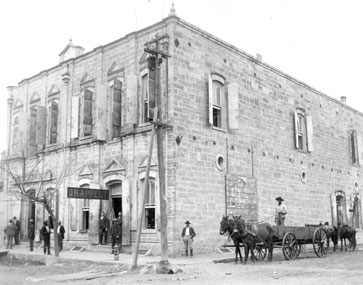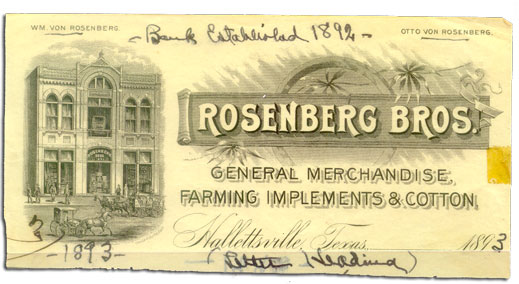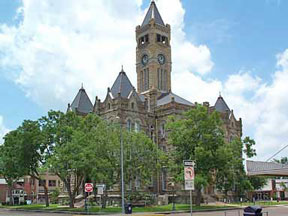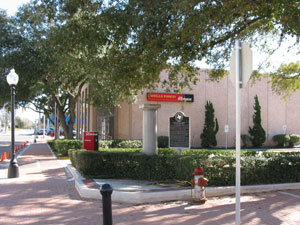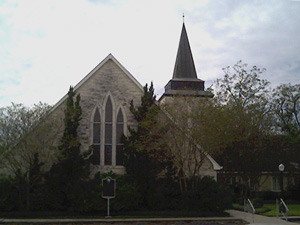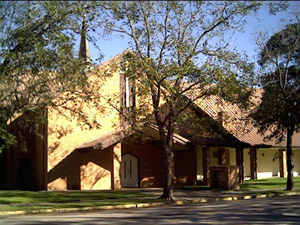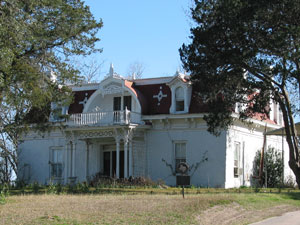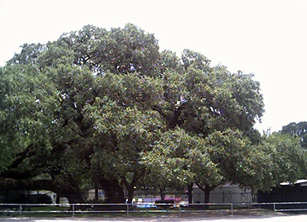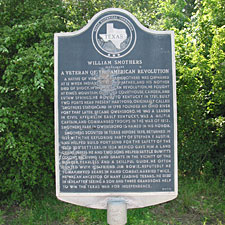From The Handbook of Texas Online:
Hallettsville, the county seat of Lavaca County, is on the Lavaca River at the intersection of U.S. Highway 77 and alternate U.S. Highway 90A, eighty miles southeast of Austin. One of the first settlers in the area was John Hallett, who received a land grant from Stephen F. Austin in 1831. After Hallett's death in 1836 his wife, Margaret L. Hallett, donated land for the townsite. Other early settlers were Collatinus Ballard, David Ives, Dr. M. B. Bennett, Ira McDaniel, and A. W. Hicks. A post office was opened in 1849. Hallettsville was chosen county seat when La Baca County was formed in 1842, but the county was afterward abolished. After Texas became a state and Lavaca County was organized in 1846, Hallettsville and the nearby town of Petersburg competed to be county seat. In an election held on June 14, 1852, Hallettsville received a majority of votes, but residents of Petersburg contested the results. Though Hallettsville was officially declared the county seat on August 28, 1852, allegations of election fraud and legal maneuvering were not completely resolved by the courts until 1860. The courthouse, which was completed in 1853, proved inadequate and was replaced in 1875. The present courthouse, built in 1897, is listed in the National Register of Historic Places. Hallettsville voted to incorporate on August 13, 1870. It surrendered its charter in 1875 but reincorporated on June 29, 1888. The population rose from an estimated 600 in 1875 to 1,700 in 1890. Many who settled in Hallettsville in the late nineteenth century immigrated from Czechoslovakia and Germany. The Alma Male and Female Institute, one of the county's first private schools, opened in Hallettsville in 1852 but was forced to close at the outbreak of the Civil War. Sacred Heart Academy was founded in 1881, and a public school system was in place by the late 1880s. In 1887 the San Antonio and Aransas Pass Railway built through the town, and Hallettsville became the principal trading center and shipping point for area farmers and ranchers. By 1892 the town owned an electricity plant and had established a waterworks supplied by artesian wells.
The Hallettsville Lone Star, begun by S. A. Benton in 1860, was the first newspaper in Lavaca County, but it folded when the Civil War began. The Herald was established in 1871. Publication of weekly newspapers in Czech and German began in the 1890s. By 1913 Halletsville, with an estimated population of 1,300 residents, had thirteen newspapers with a combined circulation of 25,000. One of these, the Rebel, was the state paper of the Socialist party from 1911 to 1917. In the late 1980s the only major newspaper was the Tribune-Herald. Much of the economy is based on agriculture. Area farmers raise cattle and grow rice, corn, hay, fruit, and pecans. The town is also the site of the Lavaca Medical Center, a portable-building plant, and a major soda-bottling plant. In 1988 Hallettsville had a population of 2,589. In 1990 the population was 2,718.
Old Hallettsville Businesses
 |
|
Appelt Building
|
|
Rosenberg Building
|
|
Historical Markers
From historical marker erected at the corner of US 77/Hwy 90-A and La Grange Street:
HALLETTSVILLE
Founded 1833 when John Hallett erected a log cabin near Lavaca River. Town was named for his widow, Margaret, who gave the land when town became county seat in 1852. Farming, livestock, poultry processing, and cotton marketing center. State Championship High School Rodeo held annually in June. 1968
Lavaca County CourthouseFifth structure to serve as seat of justice for Lavaca, created originally as "La Baca", a judicial county, by Congress of Republic of Texas in 1842. Declared unconstitutional along with other judicial counties, it was created anew by first Legislature of State of Texas on April 6, 1846, and organized on July 13, 1846. Earliest courthouse was of logs, and for an interval after that one burned, court was held under a liveoak tree in old town of Petersburg. This is third courthouse on this site since county seat was moved to Hallettsville, 1852. Richardsonian in style, it is of Mineral Wells brown sandstone and has base and trim of Mills County grey stone. Eugene T. Heiner of Houston, noted for his public buildings, was the architect. Contractors A. T. Lucas and C. H. and J. Stadtler erected the structure in 1897-1899. Led by members of Hallettsville Schuetzen Verein, Silver Cornet Band, fire department, Sons of Hermann, and other orders, county dedicated the building July 4, 1899, with Judge P. H. Green giving the main address. Courthouse square was selected by Texas Society of Architects in 1970 for a restoration study. The courthouse was placed on the National Register of Historic Places in 1971. |
|
First National Bank of HallettsvilleOldest bank in Lavaca County; has operated in this city block continuously since its establishment by Friench Simpson (1848-1923) and Carey Shaw (1854-1944), former employees of the J. H. Simpson Bank, Columbus. Shaw was also one of the original officers in the Texas Bankers Association, founded in 1885. In 1888, the San Antonio and Aransas Pass Railroad was being built through Hallettsville. When S.A.A.P. construction gang reached here, the need for a local bank became apparent, and Simpson and Shaw organized "The Lavaca Bank" as a private institution, opening for business in southeast corner of the Kroschel General Merchandise Store, in this block. In 1890, they chartered the Lavaca County National Bank of Hallettsville, and took over entire Kroschel Building. In this bank, Shaw was president; T. Y. Hill, vice president; Friench Simpson, cashier; H. M. Tippett, assistant cashier; Joe Kahn and T. H. James, directors. Present name was adopted at bank's rechartering on May 21, 1910. Carey Shaw continued as a director until 1909; Friench Simpson until October 13, 1914. Succeeding generations of the Simpson family have also served in staff and management. New building, erected 1973, occupies the original site and adjacent lots. 1973 |
|
St. Peter Lutheran ChurchThe history of Lutheran ministry in the Hallettsville area can be traced to 1868, when the Rev. Christian Geiger began missionary work among the area's German immigrants. Meeting first in the nearby Pagel settlement, a congregation was formally organized on December 21, 1889, in the home of Franz Groeber. Named St. Peter Lutheran Church, the congregation began with eight founding families and met in facilities provided by Hallettsville's Episcopal Congregation. Worship services, conducted in German and English, were held once a month. By September 1891 land was purchased for a church building, and the cornerstone was laid on December 9. The building's framework was destroyed in a storm that month, but it was rebuilt and formally dedicated on June 19, 1892. As the congregation continued to grow, the Rev. Frederick Wolfsdorff became the second pastor in 1901. Along with Anna Thekla Baessler, he organized the church's first Sunday School in 1902. Additional buildings were added to the church grounds over the years, and a new sanctuary was built in 1942. Celebrating over one hundred years in Hallettsville, St. Peter Lutheran Church continues to serve its community. - 1989 |
|
First United Methodist ChurchMethodist circuit riders under the stewardship of John W. DeVilbiss and Henderson D. Palmer served this area as early as 1842. This congregation traces its origin to a Methodist society established by eleven charter members in 1851. Early services were held in various locations, including brush arbors, homes of prominent area settlers, a schoolhouse, courthouse, and the ground floor of the local Masonic Lodge Hall. The congregation was closely associated with other Methodist churches in Lavaca County, most notably those established in the communities of Shiner and Mossy Grove. The congregation met in the Lodge Hall from 1858 until 1891 when their first sanctuary was completed. A Sunday School, choir, and a women's aid society were organized and over the years the congregation added a parsonage and an educational facility. A new sanctuary was built here in 1953. The congregation, which has generally contained more than 200 members since the early 1900s, has included among its membership a number of the community's most prominent citizens. First United Methodist Church of Hallettsville continues to serve the community with a variety of programs and activities. - 1995 |
|
First Baptist ChurchAccording to local oral tradition, Baptists in Hallettsville began worshiping together about 1851. A congregation of fourteen people was in operation by 1854. Early worship services were conducted in a three-story building which served the community as a school, Union Church, and Masonic lodge. The church's membership grew steadily, and in March 1882 the deacons purchased land in this block for a sanctuary. A frame structure was completed in 1884. It continued to serve the congregation until the early 1940s, when it was moved to another site on the property to make room for a new brick building, which was completed in 1948. Beginning in 1962, plans were again made to enlarge the church facilities. The 1884 church building was incorporated into the design for the new structure, and it remains in place under the modern brick construction. Throughout its history, the First Baptist Church has served the community with a variety of worship, educational, and outreach programs. Members of the church have maintained an involvement in both foreign and domestic missionary activities. The church continues to play an important role in the civic affairs of Hallettsville and Lavaca County. - 1991 |
|
Sacred Heart Catholic ChurchThis congregation was founded as a mission of St. Mary's Catholic Church (about four miles west of Hallettsville). The Rev. John Anthony Forest served the new congregation, as well as other missions in Lavaca County. Early worship services were held in the homes of members, most of whom had recently immigrated to Texas from Europe. Land for a church building was donated by Collatinus and Mary Jane Hallet Ballard in 1869. Construction began in 1873 and was supervised by Father Forest. After the building was completed in 1882, Sacred Heart became a full-time parish. Father Forest served as pastor until 1895, when he left to become bishop of the Diocese of San Antonio. Sacred Heart Academy, located on the grounds of the church, was established by the Sisters of the Incarnate Word and Blessed Sacrament in 1882. The parish continued to operate the school after the nuns relocated to San Antonio in 1926. An important part of Hallettsville history since its founding, Sacred Heart Catholic Church continues to serve the community and counts among its members many descendants of early German and Czech immigrants. |
|
St. James' Episcopal ChurchThe community of Hallettsville began in 1836, when Margaret Hallett donated land for the townsite. By that time, there were several families living in the area, and settlement increased throughout the 19th century. In July 1875, Gen. Arthur Pendleton Bagby and his wife Frances (Taylor) asked the Rev. Thomas J. Morris, a missionary out of Columbus, to come to Hallettsville and baptize their six children. Later that year, the Rt. Rev. R. W. B. Elliott, missionary bishop of western Texas, visited Hallettsville, and in 1876 the congregation known as St. James' was accepted into the diocese of west Texas. Church members initially met in the Odd Fellows lodge hall, which was also known as St. James Missionary Hall. In 1880, the congregation purchased a lot on east third street, and through the efforts of Mary Kroschel, Jane Viser, and the Bagby family, the church constructed its first sanctuary the next year. Many of the active early congregation members were commemorated in stained glass windows, which were moved to a new church building constructed in 1962 at this site. Throughout its history, the congregation has been a mission church, sharing ministers with other Episcopal churches in the region. In 1995, St. James' joined with seven other congregations from nearby communities to form a partnership. Together, the churches are a network of support. Locally, St. James' members participate in community service activities, including food pantries and care for the infirm. Members also work together to help national and international causes. Through worship, study, ministry and outreach, the church continues to support its members and its community. |
|
The Lay-Bozka HouseOne of distinctive structures of 19th century Texas. Sometimes called the "Wedding Cake House". Built 1878-1882 by B. J. E. Dietz at cost of $4,750 for Dr. James E. Lay, local physician and Civil War veteran. The architect was Victor Hugo, a French diplomat. Native stone walls are 18 to 24 inches thick. Wood used was cypress. Mansard roof. Windows of variant designs and sizes. Owned and preserved since 1948 by former Mayor M. I. Bozka. Recorded Texas Historic Landmark, 1968 |
|
Old Hanging TreeGallows used Sept. 12, 1879, at public hanging of "Pocket," an Indian, killer of Englishman Leonard Hyde. [Dedicated 1967] |
|
William Smothers(1760-1837) A Veteran of the Texas Revolution. A native of Virginia, William Smothers was orphaned at 12 when Indians killed his father, and his mother died of shock. In the American Revolution, he fought at King's Mountain, Guilford Courthouse, Camden, and Eutaw Springs. He moved to Kentucky in 1781, built two forts near present Hartford, originally called "Smothers Station," and in 1798 founded an Ohio river port that later became Owensboro. He was a leader in civil affairs in early Kentucky, was a militia captain, and commanded troops in the War of 1812. Smothers Park in Owensboro is named in his honor. Smothers scouted in Texas before 1820, returned in 1821 with the exploring party of Stephen F. Austin, and helped build Fort Bend for the safety of the "Old 300" settlers. In 1824 Mexico gave him a land grant; in 1826, he and two sons helped settle DeWitt's Colony, receiving land grants in the vicinity of this marker. Fearless and a skillful guide, he often hunted with his friend Jim Bowie. Reputedly he tomahawked bears in hand combat. Married twice, he was ancestor of many leading Texans. He died in 1837, after seeing a son and three grandsons help to win the Texas War for Independence. (1977) Note: According to descendants Nena Smothers and Debbie Langton much of the information on this marker is incorrect or exaggerated. His surname was actually Smeathers. In later years his grandson, John Bate Smeathers, Jr. changed the spelling to Smothers. Also, this William Smeathers was not born until after 1765, probably in Tennessee Co, NC, and there's no proof that he was orphaned. He did not participate in the American Revolution. He did serve as a private in the Tennessee County militia and he was a Capt of the Mounted Spy Unit under Major Touissant Dubois in the War of 1812.. He was married only once, to Mary Winters of Tennessee, and they had two sons and two daughters, but no descendants who were "leading" Texans. In October 1834 Smothers was deeded half a league of land belonging to James Kerr. The Bowie connection and bear story is probably an embellishment. It was actually his son-in-law, John Berry, who fought for Texas Independence, along with his 3 sons, Andrew Jackson Berry, John Bate Berry and Joseph Berry. Wm Smeathers' daughter, Betsy, was their mother. |
See Lavaca County Historical Markers page for other historical markers in the Hallettsville area.
Norma Casey contributed many of these photos of sites in Hallettsville with historical markers.
Related Links
Hallettsville Chamber of Commerce
Lavaca County Historical Museum
The Past is Still Visible: the Fey & Braunig Building
The Past is Still Visible: the H. J. Heye Building
Lone Star Diary at TexasEscapes.com website
"Hallettsville Photographer Left a Legacy of Memories, " Henry Jacob Braunig
"Old Turner Hotel Uncovered by Hallettsville Fire"
"The Grand Old Lady On The Square," Lavaca County Courthouse
"The Demise of Bad Man Buckley," James Buckley of Hallettsville
"All Were Welcome at Fink's [Finkelstein] Hotel in Hallettsville
Related Links at the Lavaca County TXGenWeb Site
Friench Simpson Library
Hallettsville City Cemetery
Hallettsville Memorial Park
New Jewish Cemetery
Old Jewish Cemetery
Sacred Heart Cemetery
Fey & Braunig, Photographers
Unidentified Photographs
1940 Hallettsville Flood
